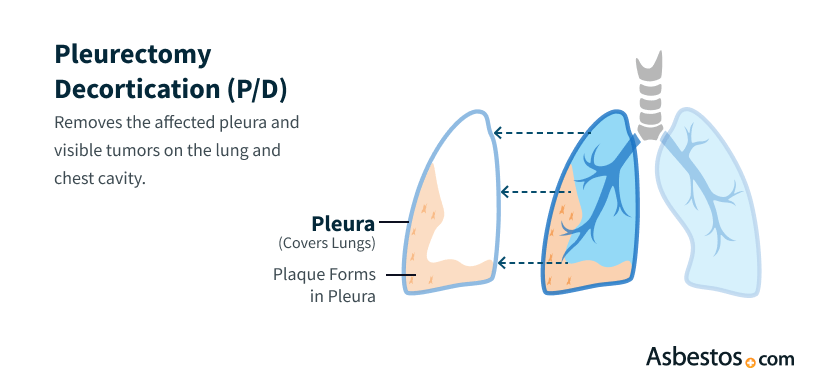Kevin Hession underwent decortication surgery to remove all visible tumors in January 2022, about 5 months after being diagnosed with pleural mesothelioma. Kevin spoke with The Mesothelioma Center to share his experiences while recovering from surgery and to explain some lasting effects from the procedure.
Pleurectomy/Decortication for Mesothelioma
Pleurectomy and Decortication (P/D) is a lung-sparing surgery for pleural mesothelioma that removes the affected pleura and visible tumor masses. This procedure aims to improve quality of life by relieving symptoms while preserving lung function.
What Is Pleurectomy/Decortication (P/D)?
Pleurectomy/decortication (P/D) surgery is a two-part procedure. The pleurectomy involves opening the chest cavity and removing the pleural lining around the lung and other visible tumor masses. Unlike more radical surgeries, such as extrapleural pneumonectomy (EPP), P/D preserves lung tissue, allowing patients to maintain lung function post-surgery.
- Lung-Sparing Surgery: Pleurectomy/Decortication (P/D) is a surgical procedure that removes the pleura and visible tumors while preserving the lung, unlike more radical surgeries like extrapleural pneumonectomy (EPP).
- Typical Surgery Duration: P/D usually takes between 4-6 hours to complete and requires general anesthesia.
- Recovery Time: Patients typically spend 7-10 days in the hospital after P/D and may need several weeks or months to fully recover.
- Improved Quality of Life: P/D can significantly reduce symptoms such as chest pain and difficulty breathing, leading to an improved quality of life for patients.
- Long History of Use: P/D has been a recognized treatment option for pleural mesothelioma for several decades, offering an alternative for patients seeking less radical surgical options.
Pleurectomy/decortication surgery is an effective treatment for mesothelioma in the lung’s lining, also called pleural mesothelioma. Removing the pleural tissue and other cancerous growths in the lung can extend survival and significantly increase quality of life.
P/D surgery is most effective as part of a comprehensive treatment approach. Studies show that this kind of multimodal approach can increase survival rates. Surgeons use postoperative chemotherapy, radiation therapy or immunotherapy to eliminate any remaining cancer cells. In addition, using adjuvant therapies can prevent or delay cancer recurrence.
How Pleurectomy/Decortication Works
The pleurectomy/decortication procedure is broken down into two key steps. Each step is vital in effectively treating pleural mesothelioma.

Step 1: Pleurectomy
In the pleurectomy portion (also known as a parietal pleurectomy) of P/D surgery, the surgeon opens the chest cavity and removes the outside layer of the lung’s lining. The surgeon removes all visible cancerous tissue. It takes between 2 and 4 hours.
At the beginning of surgery, the team carefully positions the patient on their side. To access the chest cavity, the surgeon makes a long incision along the back called a thoracotomy. The incision begins near the top of the ribcage and runs parallel to the spine before extending outward near the bottom of the ribcage.
If there is cancer in the lower chest, the surgeon may perform a second incision to reach that area of the chest cavity. In some cases, surgeons remove the sixth rib to access the entire chest cavity.
The surgeon then removes the parietal pleura, the outside layer of the pleural lining. The surgeon will also remove other cancerous tissues, including any present on the chest wall lining, heart sac or diaphragm.
Step 2: Decortication
In the decortication part, a surgeon removes cancerous or abnormal tissue from the lungs, chest wall or diaphragm. The surgeon typically performs this procedure after finishing the parietal pleurectomy. The surgeon removes any visible tumor growth and may surgically scrape the lung to ensure the removal of any malignant tissue.
“We’re finding that we’re able to remove all the tumor that’s visible,” said Dr. Andrea Wolf, director of the New York Mesothelioma Program at Mount Sinai. “That’s why there’s been a shift toward doing this lung-sparing procedure more so than in decades past.”
As the surgical team completes the procedure, they’ll take steps to prevent postoperative bleeding, such as suturing or cauterizing blood vessels. Some specialists have also integrated experimental targeted treatments such as photodynamic therapy, heated intrapleural chemotherapy or chemotherapy gels, which have shown promising results.
The final step is for the surgeon to stitch the incision closed. The decortication portion of a P/D takes about 2 to 3 hours.

Receive a free guide with the latest information on emerging treatments and clinical trials.
Get Yours NowBenefits of Pleurectomy/Decortication for Mesothelioma Patients
Pleurectomy/Decortication (P/D) is a lung-sparing approach to treating pleural mesothelioma. It allows patients to retain lung function while effectively removing tumors. The procedure has a good record of reducing mesothelioma symptoms and prolonging life.
While some surgeons debate the benefits and risks of P/D versus the more invasive extrapleural pneumonectomy (EPP) procedure, research studies show that P/D can lead to more prolonged survival. Because it’s associated with fewer complications and better quality of life, with only 1% to 2% of patients dying during or immediately after the surgery, most mesothelioma specialists today agree that P/D is preferable in cases where cancer tissue has not invaded the lung.
- Lung-Sparing Approach: P/D minimizes the impact on respiratory function by preserving lung tissue.
- Symptom Relief: Removing tumors can significantly alleviate chest pain and breathing difficulties.
- Improved Survival: Studies suggest combining P/D with other therapies, like chemotherapy or radiation, may extend survival rates.
One mesothelioma survivor, Kevin Hession, reported that undergoing P/D significantly improved his ability to breathe and participate in daily activities, emphasizing the surgery’s impact on quality of life.
Risks and Side Effects of Pleurectomy/Decortication
The main risk and side effect of a pleurectomy/decortication is an infection at the incision site. Every surgical procedure carries inherent risks. By knowing what to expect, patients can better prepare themselves and discuss worries with their healthcare providers. Here are the primary risks and side effects to consider:
- Infection: As with any surgical procedure, there is a risk of infection at the surgical site. Medical teams take precautions to minimize this risk, including administering antibiotics when necessary.
- Bleeding: Some bleeding may occur during or after the surgery. Surgeons monitor patients closely to manage any bleeding complications effectively.
- Anesthesia Complications: Adverse reactions to anesthesia, while rare, can occur. Patients should discuss any prior reactions or concerns with their anesthesiologist before surgery.
While pleurectomy/decortication is generally considered a safer option compared to more invasive procedures, it is essential to acknowledge the risks and potential side effects associated with the surgery. Awareness of these factors can help patients prepare and address any concerns with their medical team.
- Fatigue: Patients may experience fatigue in the days following surgery as their bodies begin to heal. This is a normal part of recovery, but patients are encouraged to rest and allow their bodies to recuperate.
- Temporary Breathing Difficulties: Some individuals may encounter temporary breathing challenges immediately post-surgery. Healthcare providers typically monitor these symptoms and offer supportive care as needed.
Understanding the potential risks and side effects of pleurectomy/decortication can empower patients to approach their surgery with knowledge and confidence. Discussing any concerns with medical professionals can help ensure a smoother recovery process.
Who Is a Candidate for a Pleurectomy/Decortication (P/D)?
Not all people with a mesothelioma diagnosis are eligible for P/D. Surgeons assess each individual to ensure that P/D is the appropriate treatment. P/D can treat early-stage (stages 1 an 2) pleural mesothelioma. In these stages, the cancer is confined to the chest cavity and hasn’t spread to other areas of the body, so surgery can remove all cancerous tissue.
Eligibility Criteria for P/D
Determining candidacy for pleurectomy/decortication is vital for ensuring patients receive the most appropriate treatment. Specific criteria can help identify those who may benefit most from this surgical option.
- Early-Stage Diagnosis: Patients with localized cancer are often the best candidates for P/D, as they stand to benefit most from the procedure.
- Overall Health: Candidates should be in good general health, with no significant comorbidities that could complicate surgery or recovery.
- Tumor Size and Location: The size and location of the tumors also play a crucial role in determining whether P/D is a viable option.
Individuals who are eligible for P/D may also benefit from additional therapies. These may include chemotherapy or radiation to destroy cancer cells further and prevent the progression or recurrence of disease.
Findings presented in 2023 raised questions about the efficacy of P/D and chemotherapy compared with chemotherapy alone. The study showed that chemotherapy alone may offer better outcomes than chemotherapy with surgery. The subject will require further study, and individuals should discuss all treatment options with their mesothelioma care team.
Factors to Consider
Several factors influence the decision to pursue pleurectomy/decortication. These factors deals with some factors you cannot control such as age and cancer stage.
- Age: Younger patients generally have better surgical outcomes due to their overall health and resilience.
- Lung Health: Patients with good lung function are more likely to qualify for P/D, as the procedure aims to preserve lung capacity.
- Stage of Cancer: The earlier the stage of cancer at the time of diagnosis, the more suitable a patient may be for P/D. Advanced stages often require more aggressive treatment options.
By carefully considering these factors, patients can make informed decisions about their treatment options and work closely with their healthcare providers to find the best path forward.
Consulting With a Mesothelioma Specialist
Patients considering P/D should consult with a mesothelioma specialist. These experts can evaluate individual health conditions, provide personalized recommendations, and discuss potential risks and benefits associated with the procedure. Their insights can help patients make informed choices about their treatment plans.
Patients may meet in person or virtually with the surgeon and the surgical team. They can ask detailed questions, raise concerns and inquire about the surgeon’s success rate.

Get help paying for mesothelioma treatment by accessing trust funds, grants and other options.
Get Help NowPleurectomy/Decortication Surgery Preparation and Recovery
Preparation for pleurectomy/decortication surgery involves several essential steps to ensure a successful outcome. Understanding what to expect can alleviate anxiety and help patients feel more confident as they approach their procedure.
Being well-prepared for surgery can contribute to a smoother experience and recovery. Here are the primary steps involved in preparing for pleurectomy/decortication:
- Pre-Surgery Tests and Assessments: Before the surgery, patients will undergo various tests, including imaging scans and blood work. These evaluations help doctors assess overall health and readiness for surgery.
- Discussions With the Surgical Team: Patients should take this opportunity to ask questions and clarify any concerns they have about the procedure, anesthesia, and recovery.
- Adjustments to Medications: Patients may need to pause or adjust certain medications in consultation with their healthcare provider, especially blood thinners or other drugs that could impact surgery.
Proper preparation for pleurectomy/decortication surgery is crucial for a successful experience. Patients can set themselves up for a positive surgical outcome by following pre-surgery steps and maintaining open communication with their healthcare team.
Recovery After Pleurectomy/Decortication
Most individuals require a hospital stay of about 2 weeks after P/D, so doctors monitor recovery closely. The staff can identify signs of complications such as infection, pneumonia or bleeding and take appropriate action. The care team can use the time to teach patients deep-breathing exercises and other therapies to aid recovery.
Total recovery from surgery usually takes several more weeks after hospital discharge. The care team will provide detailed instructions on how to continue recovery at home and arrange for any necessary visits from occupational and pulmonary therapists. Some patients may be eligible for complementary therapies, such as pulmonary rehabilitation. Following care instructions and attending follow-up appointments will safeguard patient health.
Common Questions About Pleurectomy and Decortication (P/D) Surgery
- Are pleurectomy and decortication surgeries effective?
-
Pleurectomy and decortication have a 90% success rate in reducing symptoms and can increase survival time to about 20 months. It’s not considered a cure for mesothelioma, but this surgery is among the most effective treatment options when combined with a multimodal mesothelioma treatment approach.
- What is the survival rate and life expectancy of someone who undergoes P/D surgery?
-
The median survival after P/D is about 20 months, depending on other prognostic factors, such as the stage of mesothelioma, treatment approach and patient health status. Multimodal treatment protocols may improve survival rates.
- How long does pleurectomy surgery take?
-
P/D typically takes between 4 to 6 hours to complete.
- Can pleurectomy cure mesothelioma?
-
While P/D can remove tumors and alleviate symptoms, it is not considered a cure for mesothelioma. Comprehensive treatment often involves multiple modalities.
- Is P/D better than extrapleural pneumonectomy?
-
P/D is often seen as a less invasive option than extrapleural pneumonectomy, particularly for patients looking to preserve lung function.




